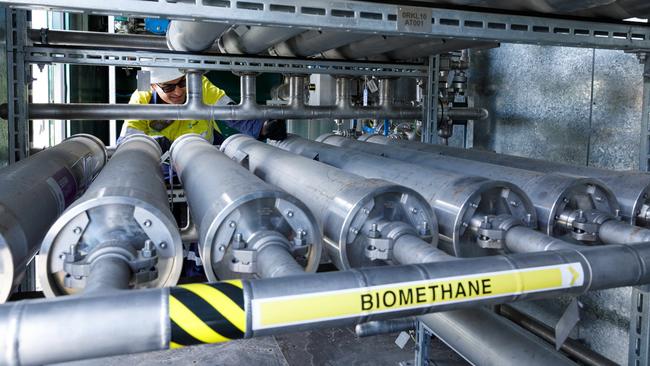Australia’s gas distributors on the cusp of managed decline as demand curtailed: S&P
A new report says the move by states and territories to curtail the use of gas as a fuel source will have a material impact on the country’s gas distributors in the coming years.
Business
Don't miss out on the headlines from Business. Followed categories will be added to My News.
Australia’s gas distributors are on the cusp of a managed decline and they will endure sluggish growth in returns and heightened pressure to cut debt as states and territories move to curtail the use of the fuel source, S&P has said.
The report underscores the disruption caused by Australia’s rapid energy transition. The country has set ambitious targets of having renewable energy generate more than 80 per cent of the country’s electricity by 2030.
To achieve transition targets, Canberra and Victoria have moved to ban new gas connections, while both have offered sweeteners to households to electrify.
Canberra and Victoria are Australia’s most gas-dependent regions, with tens of thousands of households relying on the fuel source for heating. The move could aid Australia’s gas supplies, with domestic supplies across the country’s east coast dwindling, but S&P said the trend will have a material impact on companies such as Jemena and AusNet Services – albeit slowly.
With customer numbers expected to decline gradually, returns will fall and the companies will be under increased pressure to pay back debt, S&P concluded, although the agency said it did not expect a sudden or rapid decline over the next seven to 10 years.
The pace of the impact, however, will also be affected by technological changes – most notably whether hydrogen becomes commercially viable.
The role of hydrogen is the subject of much debate. Some believe hydrogen is fast becoming a serious contender to power homes and businesses, others see it as a smaller, export-orientated market.
If hydrogen emerges rapidly, existing gas infrastructure could be repurposed to allow hydrogen to be used in homes and businesses with some modifications.
Should that trend emerge, gas distributors would have an ongoing opportunity.

But most analysts don’t see hydrogen as a domestic fuel source and will instead be a possible substitute for LNG for resource-poor countries for electricity generation or for Australian industries unable to electrify.
If that trend materialises, gas distributors will have to hasten efforts to find future growth.
Jemena earlier this year moved to promote a new market, injecting biomethane – created from organic waste – into its gas pipelines across NSW that it hopes will spur the establishment of a renewable gas industry.
Biomethane is widely used overseas but has not taken off in Australia as it struggles to financially compete with natural gas.
A renewable gas target would compel retailers to use biomethane, which supporters such as Jemena say would ease supply pressures facing Australia’s east coast markets and support the transition away from fossil fuels.
Jemena said its research has found there are enough potential sources of biomethane – wastewater plants, landfill and food, agricultural, and crop waste in NSW – to generate about 30 petajoules of biomethane each year. This is approximately enough gas to meet the needs of all of Jemena’s current residential customers in NSW, the company said.
The Australian Energy Regulator estimates that households and businesses across the country’s east coast use about 580 petajoules of gas each year. If Jemena’s research is correct, biomethane could supply about 5 per cent of the needs of Australia’s east coast.
Supplementing the fuel sources of Australia’s east coast would be appealing to authorities as supplies of gas are expected to wane.
ExxonMobil – one of Australia’s largest producers of domestic gas – this year said its Gippsland Basin joint venture, which historically supplies more than 70 per cent of southeast Australia’s domestic gas demand, was rapidly dwindling.
ExxonMobil said the number of producing wells had shrunk from 122 in 2010 to 68, and would drop to 36 by winter 2024.
The structural deficit leaves Australia’s east coast facing an uncertain future. New developments have been curtailed in NSW and Victoria, while new pipelines would be needed to unlock potential supplies in Queensland and the Northern Territory.
More Coverage
Originally published as Australia’s gas distributors on the cusp of managed decline as demand curtailed: S&P





